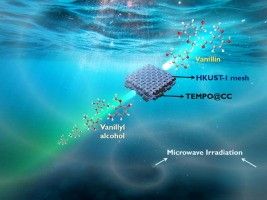循環農業:農業廢棄物高價值化【環境工程學系/林坤儀特聘教授】
| 論文篇名 | 英文:Integrated MOF-mesh and TEMPO-grafted carbon fiber as a sandwich-like catalytic system for selective valorization of lignin-derived compound under microwave irradiation 中文:集成 MOF 網和 TEMPO 接枝碳纖維作為夾層狀催化系統,用於微波輻射下木質素衍生化合物的選擇性增值 |
| 期刊名稱 | Chemical Engineering Journal |
| 發表年份,卷數,起迄頁數 | 2021 , 411, 128605 |
| 作者 | Lin, Jia-Yin; Wang, Haitao; Oh, Wen Da; Lee, Jechan; Kwon, Eilhann; You, Siming; Lin, Chia-Hua*; Lin, Kun-Yi Andrew(林坤儀)* |
| DOI | 10.1016/j.cej.2021.128605 |
| 中文摘要 | 香草醇氧化成香草醛代表了木質纖維素生物質可持續價值化的關鍵一步。儘管Cu和2,2,6,6-四甲基哌啶1-氧基(TEMPO)催化氧化香草醇有希望用於香草醇氧化,但傳統的Cu/TEMPO採用均質的Cu離子和TEMPO,難以回收和再利用.在這項研究中,開發了一種獨特的三明治狀催化系統 (SCS),它包括 HKUST-1 網和接枝在碳布上的 TEMPO,被開發為香草醇氧化的多相催化劑。通過電化學技術,銅 (Cu) 網被用作 Cu 的來源以直接生長 HKUST-1,而碳布通過 TEMPO 通過共價鍵功能化。然後將這些所得材料堆疊起來,以實現 HKUST-1 和 TEMPO 之間的逐層接觸,並使 VAL 氧化的流通反應成為可能。特別是,這種 SCS 在微波輻射下表現出比傳統烤箱加熱高得多的香草醇向香草醛的轉化率。 SCS 可以在 120°C 下 60 分鐘實現 100% 的轉化率、100% 的選擇性和 100% 的香草醛收率。這種將香草醇完全轉化為香草醛的過程幾乎超過了文獻中其他工藝的所有報告值,而且 SCS 也可以重複使用並持續實施以將香草醇轉化為香草醛。使用的 HKUST-1 網格可以保留 HKUST-1 的晶體結構,而 TEMPO 也保留在 TEMPO@CC 上,表明 SCS 將是一種穩定且可重複使用的集成催化劑,用於將香草醇氧化為香草醛。 |
| 英文摘要 | Oxidation of vanillyl alcohol to vanillin represents a critical step towards sustainable valorization of lignocellulosic biomass. Although catalytic oxidation of vanillyl alcohol by Cu and 2,2,6,6-tetramethylpiperidine 1-oxyl (TEMPO) is promising for vanillyl alcohol oxidation, the traditional Cu/TEMPO adopts homogeneous Cu ions and TEMPO, which are difficult for recovery and reuse. In this study, a unique sandwich-like catalytic system (SCS), which comprises HKUST-1 mesh and TEMPO-grafted on carbon cloth, is developed as a heterogeneous catalyst for vanillyl alcohol oxidation. Through the electro-chemical technique, copper (Cu) mesh is used as a source of Cu to grow HKUST-1 directly, whereas carbon cloth is functionalized by TEMPO via covalent bonds. These resultant materials are then stacked to achieve layer-by-layer contacts between HKUST-1 and TEMPO, and enable flow-through reactions of VAL oxidation. Especially, such a SCS exhibits much higher conversion of vanillyl alcohol to vanillin under microwave irradiation than conventional oven heating. SCS could achieve 100% of conversion, 100% of selectivity and 100% of yield of vanillin at 120 °C for 60 min. This full conversion of vanillyl alcohol to vanillin surpasses almost all the reported values by other processes in literature, and SCS could be also reusable and continuously implemented for vanillyl alcohol conversion to vanillin. The used HKUST-1 mesh could retain crystalline structures of HKUST-1, whereas TEMPO is also preserved on TEMPO@CC, indicating that SCS would be a stable and reusable integrated catalyst for vanillyl alcohol oxidation to vanillin. |
| 發表成果與本中心研究主題相關性 | 透過本研究可進一步建立可用於循環農業中將農業廢棄物及衍生物轉換成價值附加產物之技術。 |







